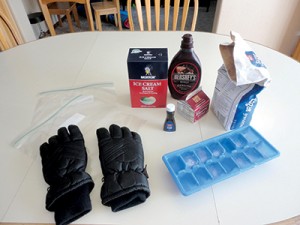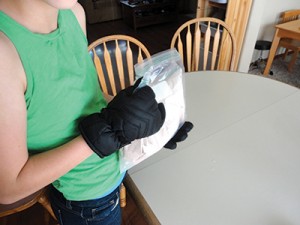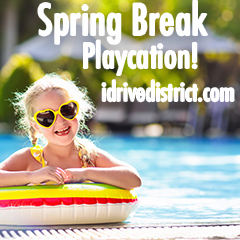Ice Cream in a Bag
 It’s summertime and the weather is super hot. Your kids need a cool treat. Plus, you could use another activity to keep them busy, right? You can help them learn about the science behind ice cream! Here is a simple science experiment that will produce a tasty treat.
It’s summertime and the weather is super hot. Your kids need a cool treat. Plus, you could use another activity to keep them busy, right? You can help them learn about the science behind ice cream! Here is a simple science experiment that will produce a tasty treat.
Materials:
- 2 tablespoons sugar
- 1 cup half-and-half
- ½ teaspoon vanilla extract
- ½ cup ice cream salt
- Ice cubes
- 1 quart-sized Ziploc bag
- 1 gallon-sized Ziploc bag
- Winter gloves
Directions:

Mix the half-and-half, vanilla, and sugar in the quart-sized bag and seal it tightly.- Fill the gallon bag halfway with ice cubes and the salt.
- Put the small bag into the larger bag and seal the outer bag.
- While wearing gloves, take turns with the kids shaking the bags for 5 minutes or until the mixture inside has turned to ice cream. The bag gets super cold, so do not touch the ice directly.
- Remove inner bag and wash off the salty water from the opening (you don’t want to get the brine into the ice cream and ruin the delicious flavor).
- Serve and enjoy!
The science behind the experiment
In order for ice cream to achieve its texture, it needs to be extremely cold ─ colder than ice normally is. Explaining why salt gets ice to drop below zero is a tricky thing, even for much older kids. Ice is a solid form of water where certain bonds happen (called hydrogen bonds). In order for the ice to melt, it needs to break those bonds and that takes energy/heat. That’s why ice feels cold: it is drawing heat away from your hand in order to melt. When you add salt to the mix, you are basically adding more stuff to be pulled apart after it dissolves in the water. It needs more energy to do this and, thus, it gets colder. Whew!
 Can you clue your kids into that? If not, don’t worry. They’ll be more interested in eating the tasty concoction that they hand-made. The scientist inside of them will then want to experiment a bit; and probably with other flavors besides vanilla.
Can you clue your kids into that? If not, don’t worry. They’ll be more interested in eating the tasty concoction that they hand-made. The scientist inside of them will then want to experiment a bit; and probably with other flavors besides vanilla.
To have them see how cold the ice can get (without touching it, of course… it is really cold), put some ice into an empty food can. On a humid summer day, water droplets will condense on the outside of the can. Get another can with ice in it and stir in a handful of ice cream salt. The can will get so cold that it will skip the condensation and, immediately, a thin frost will form around it.
Remember, you don’t have to be a scientist to do science. There are easy ways to experiment alongside your children with things right in your own kitchen.
Steve Davala is a middle school science teacher who likes to write. He also tries to think of things he can do to keep the minds of his own children active. Visit him at www.SteveDavala.com.








